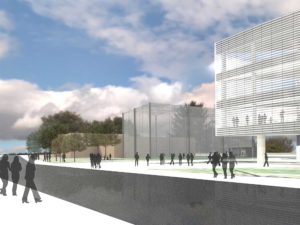
Students returning to the University of Michigan this fall will be greeted by a new construction site for an outdoor testing lab for autonomous drones.
The university’s College of Engineering recently announced the creation of M-Air, a four-story drone-testing complex to be sited near the proposed Ford Motor Company Robotics Building in Ann Arbor.
“M-Air will allow us to push the edge of our algorithms and equipment in a safe way, where the worst that can happen is it falls from the sky,” said Ella Atkins, professor of aerospace engineering in a press release. “With this facility, we can pursue aggressive educational and research flight projects that involve high risk of fly-away or loss-of-control—and in realistic wind, lighting and sensor conditions.”
Researchers hope to test advanced drone tech for a myriad of uses including package delivery, environmental data research, national security and disaster mitigation.
The facility will be netted to avoid any safety issues with errant drones. The Ford lab will provide researchers with an indoor lab space to develop drone and other robotics projects. The building will include a three-story fly zone where drones can “perch on walls or ceilings and interact with the environment,” Atkins said.
Because university policy dictates a formal approval process for outdoor drone flight that could hamper research efforts, having a netted facility will classify test flights as “indoor” — not subject to the policy.
“[Regulations] don’t guarantee safety,” Atkins said. “They’re intended for responsible, experienced pilots, and on more tested systems. Our students aren’t experienced pilots. They, and our faculty members, are building new hardware that’s not necessarily going to work the first, second, third, or even the fourth time.”
“When M-Air opens, Michigan Engineering will be the only engineering school in the country—perhaps in the world—with access to cutting-edge robotic test facilities for air, sea and land,” aerospace engineering Alec Gallimore, the Robert J. Vlasic Dean of Engineering and a professor of aerospace engineering.
Netted drone testing complexes have proven an effective solution for university training programs, given that many state laws prohibit “outdoor” flights over college campuses.
In 2015, Kansas State University-Salina erected a “drone dome” in partnership with Westar Energy. The UAS pavilion is one of the largest enclosed UAV flight facilities in the U.S. – 300-feet-long by 200-feet-wide and 50-feet-tall. The facility has been dubbed a “batting cage for drones.”
“From an aerial robotics education perspective, this facility is enabling the notion of, ‘If you can imagine it, you can try it out,'” Atkins said of the Michigan facility. “My vision is to get a lawn chair and sit out there as much as possible.”
Jason is a longstanding contributor to DroneLife with an avid interest in all things tech. He focuses on anti-drone technologies and the public safety sector; police, fire, and search and rescue.
Beginning his career as a journalist in 1996, Jason has since written and edited thousands of engaging news articles, blog posts, press releases and online content.
Email Jason
TWITTER:@JasonPReagan
Subscribe to DroneLife here.







[…] 2017, the university’s College of Engineering began work on M-Air, an outdoor fly lab created to test autonomous aerial vehicles. Now, the four-story drone-testing […]